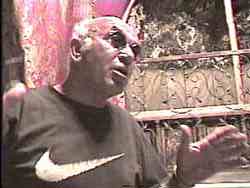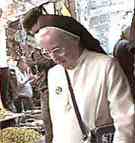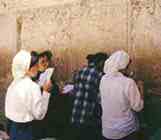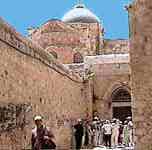Standing atop Jerusalem’s Mount of Olives, Mikhail, our Israeli guide, outstretched his arm toward the nearby vista of the Holy City. "The Old City spreads before you," he shouted. "Layer upon layer of history -- that’s 3,000 years of history you’re gazing upon. Most of the walls that you see were last built around 400 years ago by the Turks. Look at the large dome. It’s gilded -- totally covered in gold leaf. That’s the Dome of the Rock, completed in 691 AD by the Arab Muslims. It’s built on the site of the destroyed temples of Solomon and Herod.
Mikhail continued, "Now look down at the base of this hill. This is one of the main sites of Christianity. There among the olive trees is the Gethsemane Garden, where Jesus prayed, and where he was captured by the Romans prior to his crucifixion."
|
A tour of Jerusalem is almost too much for the mind and body to absorb. Even the well-prepared tourist, recently steeped in the history, feels overwhelmed by the onslaught of sights and sounds at the major sites. Muslim, Jew, Palestinian, Greek Orthodox, Catholic, Protestant, pilgrims from around the world converge here. With the variety of cultures and religions which honor Jerusalem as their Holy City, it is no wonder that the images and facts meld and intermingle in one’s mind. You truly feel as if you are in the cradle of civilization.
A Top-Rate Guide |
Early that morning our group of U.S. tourists had been cleared by Israeli police to debark our cruise ship in the port of Ashdod to enter Israel. After meeting Mikhail, we had boarded buses for the one-hour trip to Jerusalem. Mikhail is one of Isram World’s top-flight guides. Any first-time tourist in the Holy Land appreciates the services of someone like him. Like other guides from Isram World, the large tour operator, Mikhail is an Israelite who has lived in the region for over 40 years. He has a broad-based knowledge and perspective of the region’s history and the religions. His sharp wit and energy kept us on our toes and totally absorbed. Mikhail was also very frank in explaining the challenges which currently face the nation of Israel in today’s Middle East. |
Across Israel
You realize the smallness of Israel, only the size of Massachusetts, when crossing its 50-mile width, west to east. The landscape is similar to that of southern California. In the west are fertile farm lands with fields of tomatoes, cotton, and other hot-climate crops. Then the road starts climbing into the drier Judean hills where you view fruit orchards, vineyards, and untilled regions of yews and pines. Dotting the terrain are the remains of exploded, burned-out military vehicles. Mikhail offered an explanation, "In 1948, soon after the the nation of Israel was founded, the Jordanians cut off our access to Jerusalem. Their army was superior to ours and the Israeli Tank Patrol lost many men here. These relics have been left in memory of those battles. After many months a new road to Jerusalem was blazed and the city was saved." Mikhail also interspersed information on Israel’s current internal strifes with its 39 political parties, the intertwining of religion and state (there is no constitution, only the Hebrew Torah), and some key demographics.
The Maze of Jerusalem
As we drove down the eastern side of the Judean hills, Jerusalem loomed at the edge of the Negev desert. We drove around the city to the Mount of Olives for the best view. With 25,000 people of almost every religious persuasion crammed into one square mile, the Old City is the flame of passion for their cultures and beliefs. The biggest section is the Muslim Quarter, which contains the Via Dolorosa (The Way of the Cross) and the Temple Mount (Islam’s Dome of the Rock). The other sections are the Armenian Quarter, the Christian Quarter (Church of the Holy Sepulchre), and the Jewish Quarter.
 |
 |
 |
 |
We debarked from the bus with Mikhail to enter the Old City through the Dung Gate. We soon came upon the Western Wall, often called the Wailing Wall. "This is a major prayer site for the Jews," said Mikhail. "Prayers are offered here to honor the original Temples of Solomon and Herod, as well as for personal intentions." Mikhail continued, "Prayers are written on small pieces of paper and left in the cracks. This wall is the only remaining section of Herod’s Temple of 37 BC. It in turn was built upon the site of Solomon’s Temple, built to house the Ark of the Covenant, around 900 BC. Now the Wall is organised like a synagogue, with men on the left and women on the right." And so the tour group also split by gender to visit the appropriate side. A large Jewish group was celebrating bar mitzvahs in the main square.
 |
 |
 |
"Follow me very closely now," said Mikhail. "We have a lot of ground to cover, the streets are tight and crowded; you will be accosted by many vendors. Don’t hold on to anything handed to you...unless you intend to buy it. Keep your eyes open, your mind alert. When we get to the Via Dolorosa, we will stop at the Stations of the Cross."
Via Dolorosa and the Holy Sepulchre
On entering the Arab Quarter, all seemed an explosion of people, sounds, colors, and smells -- commotion on all sides. Winding our way along the El Wad Road we soon reached the even narrower Via Dolorosa. Delivery vehicles beeped their horns, adding to the commotion. We stopped at Station III. At this spot where Jesus is believed to have first fallen under the weight of the cross, there is only a small relief sculpture over a doorway. Other stations along Via Dolorosa were similarly marked. "Remember that the exact locations of these stations were selected by Helena, mother of Constantine in the 4th century. The important thing is that this is the direction that Jesus carried the cross. Now we will visit the site of Jesus’ crucifixion and burial, stations X through XIV."
 |
 |
 |
The feelings of Christians visiting the Holy Sepulchre today are an ambivalence of reverence and disappointment. The reverence comes from knowing that this is honored as the site of Jesus’ Crucifixion and his internment in the tomb. The disappointment comes from realizing that the original Byzantine Church, built by Helena in the 4th century, was destroyed by the Persians in 614 AD, and again by the Muslims in 1009 AD. The current building dates from the 12th century Crusades. There is also disappointment in seeing differing levels of grandeur and maintenance on the three church sections claimed by Greek Orthodox, Roman Catholic, and Armenian Christians. Today’s Christians need to look past this in order to appreciate the site for its central significance in their beliefs.
Much More to Experience
 |
As our intense day continued, we visited many other sites and shared other moving experiences. The reality of ongoing mid-East tensions came alive as we crossed the West Bank Israeli border station into Palestinian-owned Bethlehem. Again, there were many ambivalent feelings of confusion, tension, and reverence in Bethlehem. As we drove over the mountains and back down to the Israeli coast, passing sites such as the valley where David and Goliath battled, we were each reflecting on the meaning of this visit. Certainly we had all expanded our understanding of the significance of the great religions, as well as their history. A lifetime could be spent exploring Palestine. |
Click here for a summary of Palestine’s incredible history.
Click here for details to plan your own trip to Jerusalem.
Les Furnanz
Photos: Rita Furnanz